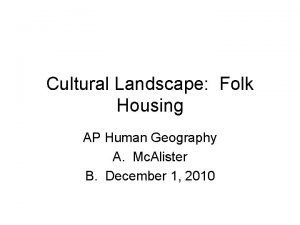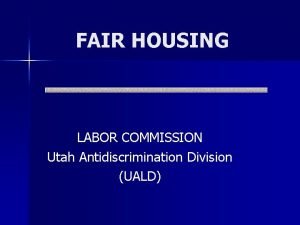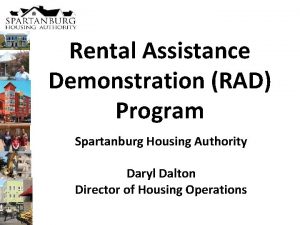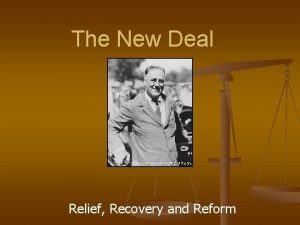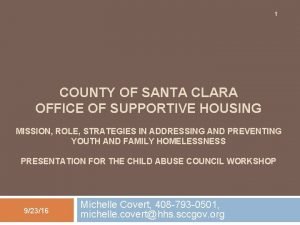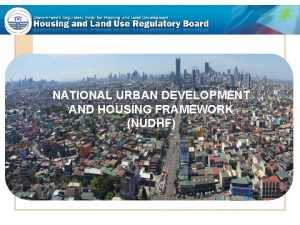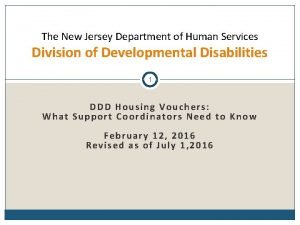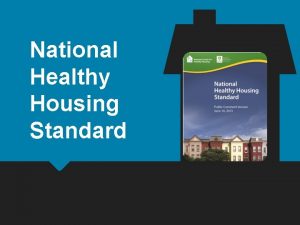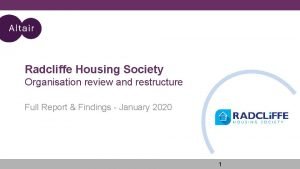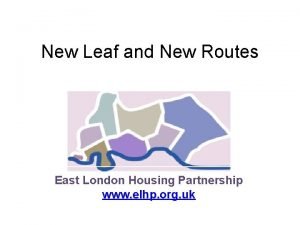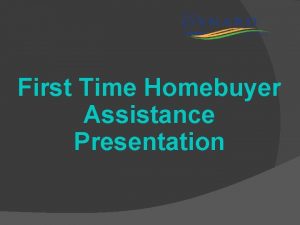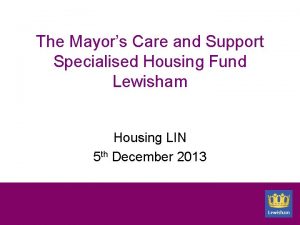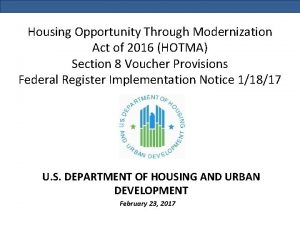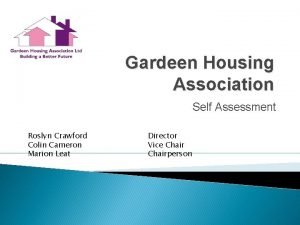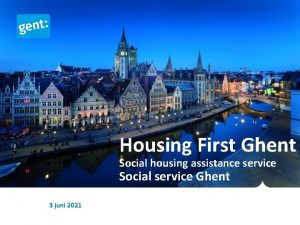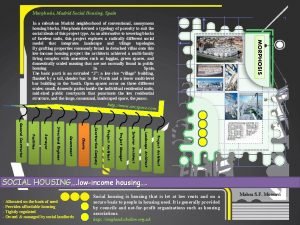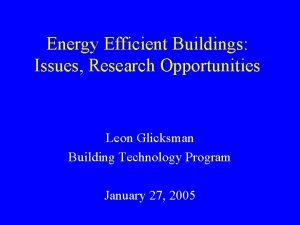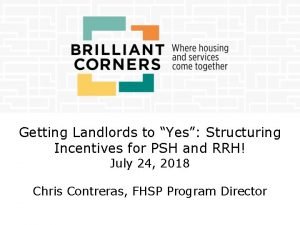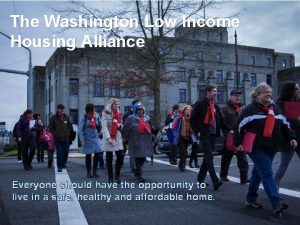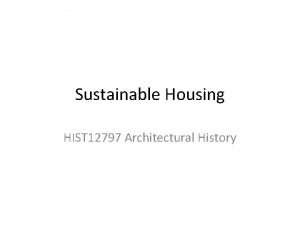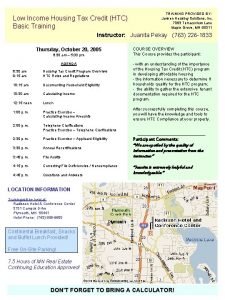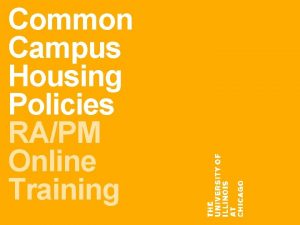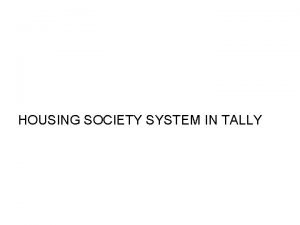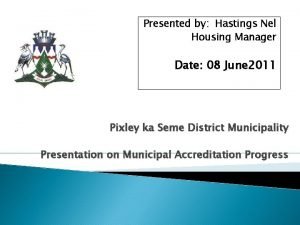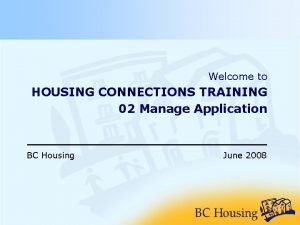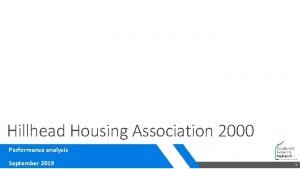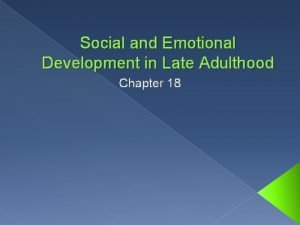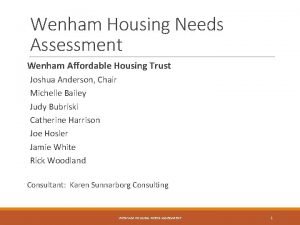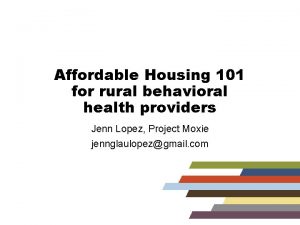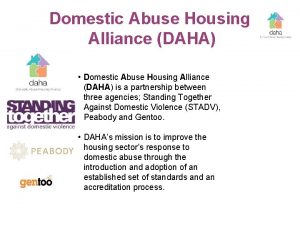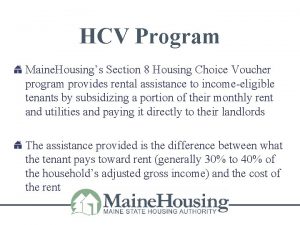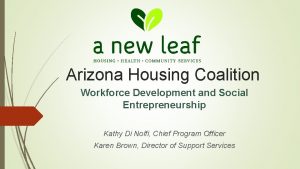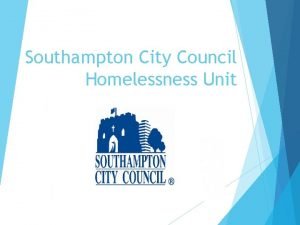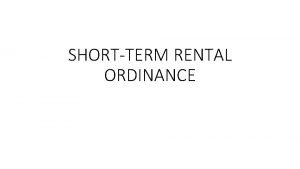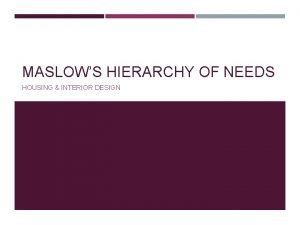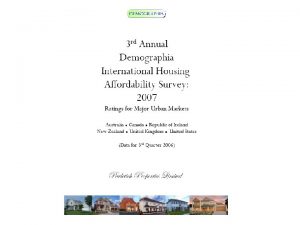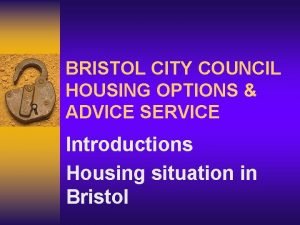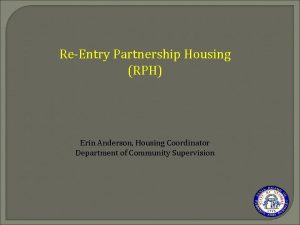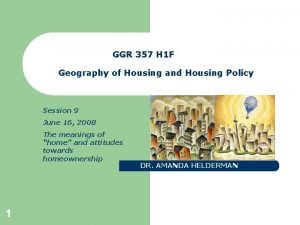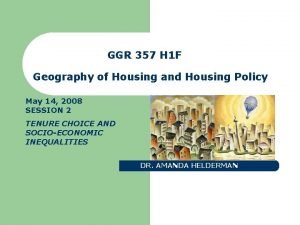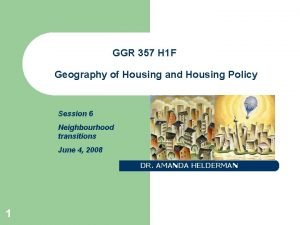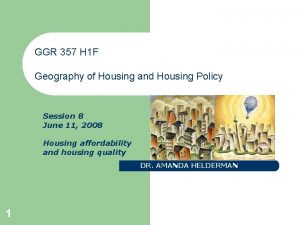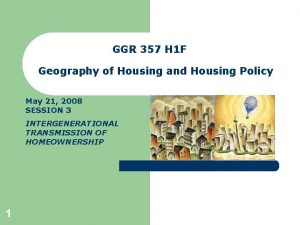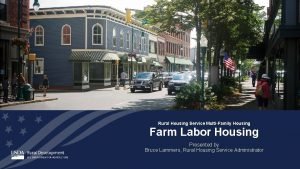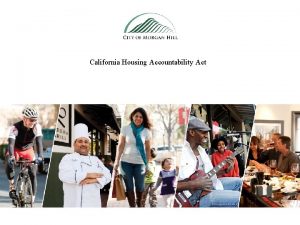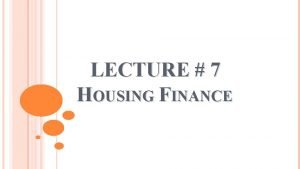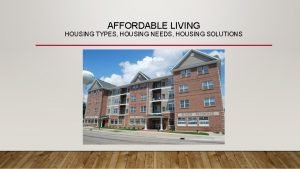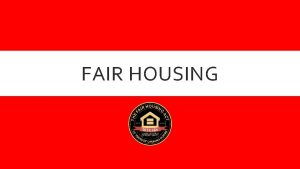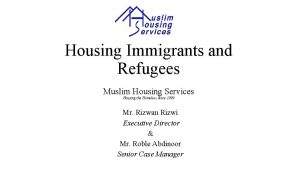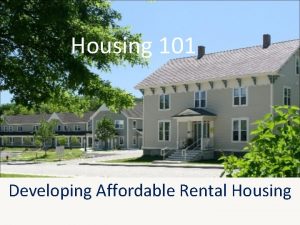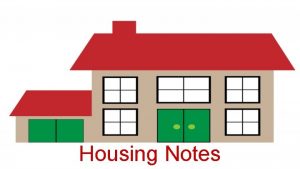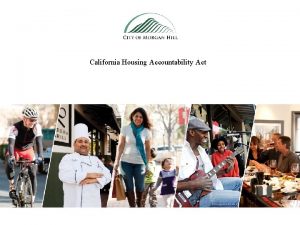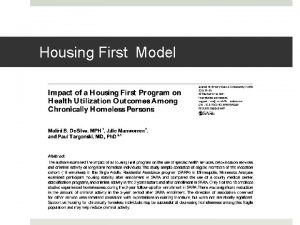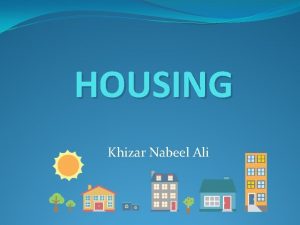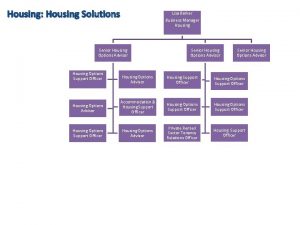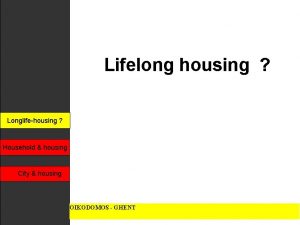GGR 357 H 1 F Geography of Housing




































































- Slides: 68

GGR 357 H 1 F Geography of Housing and Housing Policy Session 4 May 26 th, 2008 Unequal opportunities and social exclusion 1 DR. AMANDA HELDERMAN

Announcements l Web page: http: //individual. utoronto. ca/helderman l TODAY: last chance to buy your copy of the text book l Midterm exam (20%) about all texts, slides and topics read and discussed until then – – – l 2 June 2, 2008 (Monday!): 5 -7 pm Lash Miller Room 158 Assignment (35%): due date June 20, 2008

Assignment l Detailed description and helpful resources at: http: //individual. utoronto. ca/helderman l Research paper with required elements: – – – 3 One of the main topic discussed during course (introduction) Toronto neighbourhood (introduction) Clear and appropriate research question and concise conclusion Geographic description (Map/ Sketch as illustration) Demographic (Tables) Socioeconomic (Tables) Meat/ Middle

Assignment 1. Introduction 1. Topic/ Problem, grab reader’s attention 2. Societal relevance (e. g. disadvantaged groups, better housing provision for all) 3. If possible academic relevance (e. g. not researched before, new paradigm, new facts, information lacking before, action has been taken, new effects) 4. Research question (includes question mark, is feasible) 5. How you plan to answer this question (=method, lit research and analyzing City of Toronto data) Less than a page, 12 pts font 4

Assignment 2. Background (= literature review) 1. What is known about how it works? 2. How does this compare to what is happening in the neighbourhood? 1 -1. 5 pages Font 12 Single line spacing No stretched margins! 5

Assignment 3 -5. Data analysis 1. Physical (some attention for other functions than residential and green spaces) 2. Demographic (who lives there? , ethnicity, family composition etc. ) 3. Socio-economic (income, level of education etc. ) 2 pages 6

Assignment 6. Conclusion 1. Answer to your research question (adjust your question if you cannot answer) 2. Discussion/ Reflection (add some thoughts on certain circumstances or lack of data that may have affected your outcome) Less than a page 7

Assignment REFERENCES – – – Use of readings required for this course Additional relevant resources (non-academic media if you have to or if it is great added value) Proper referencing: preferably APA style Not more than three additional resources (that you have found yourself) are necessary, depending on your topic. Some topics are covered better in this course than others. Digital (email) and hardcopies (drop box 5 th floor Sid Smith) on June 20, 2008 8

Announcement final exam l 9 Final exam dates…

Introduction l l l l l 10 Definitions and excluded groups Link with housing Roots in (changing and locally different) welfare state principles Backgrounds of social exclusion Mechanisms of social exclusion Types of housing discrimination (see Novac) Role of private agents Racial, gender and spatial discrimination Mechanisms of exclusion in the public domain

Introduction l l 11 Consequences of social exclusion (special attention for homelessness) Policy discourses Policy instruments Literature

Social exclusion 12 l “Social exclusion occurs when people or groups decide consciously or unconsciously to put up barriers, preventing others from full and equal participation, leading to loss of rights, loss of power, lack of integration into society, affecting the ability to live fully” l Social exclusion accentuates material and social deprivation

Social exclusion l l 13 Diversity of experiences of social exclusion Three key dimensions of social exclusion: economic, political, and social (Somerville, 1998) Access to resources (ec), democratic decision-making (pol), services, social networks and supports (soc) Economic and social conditions tend to exclude some groups from the cycle of opportunities

Social exclusion l l l 14 Depends largely on income and the degree of forced dependence on state benefits and services Almost entirely an urban problem: cities concentrate and intensify social problems Causal relationship income and other attributes difficult to specify (basis social participation…)

Social exclusion l 15 Denial of social rights or non-realization of social rights

Concept social exclusion l l l 16 Advantage: beyond material disadvantage (compare poverty) Disadvantage: so broad in scope that almost everyone can be socially excluded in one way or the other obscures true inequalities More imprecise and hard to measure, politically convenient! Used interchangeably with poverty and social segregation Paradigm lost? Consensus: It is a problem, and it is linked with labour market position

Introduction l Who suffers from social exclusion? – – – 17 elderly people living on an inadequate income people with physical and mental disabilities young people without educational attainments women in low-income families migrants and ethnic minorities low-income, single-parent families young people leaving care long-term unemployed gays and lesbians homeless people prisoners and their families

Groups of exclusion Social perceptions of the excluded group l Attitude of the state l Role of popular media l Continuum of exclusion l Hierarchy of moral credibility l Some considered more deserving than others (single parents), some not recognized at all (disabled) l 18

Social exclusion and housing l l l l 19 Housing is a basic need for everyone Shelter Maslow’s hierarchy of needs (psychology) Theory of human motivation First ‘deficiency needs’ must be met Needs given in by the basic need for survival Housing is a deficiency need Then a person is ready to act upon ‘growth needs’

Maslow’s hierarchy of needs 20 Housing

Social exclusion and housing l l l 21 Housing is the main item on the household budget Fixes “social location” Housing is an arena of social exclusion and housing plays a role in social exclusion from other arenas Housing shapes social exclusion outcomes; health, job opportunities, education opportunities Exclusion from housing, exclusion through housing

Exclusion from housing l l 22 Central focus on unmet housing demands Failure to secure adequate accommodation Homelessness Adequate housing as a right of citizenship itself?

Exclusion through housing l l l 23 Focus shifts outwards Impact of housing system on broader social participation Housing consumption may impair access to wider citizenship rights

Social exclusion and housing l l l Links in this course: housing affordability, socioeconomic inequality, and social segregation Housing discrimination Link between social exclusion and housing: Tenure (wealth) – Housing conditions (health, especially in childhood) – Process of spatial concentration of disadvantage -> Spatial segregation – Neighbourhood level: social cohesion reduces social divides l 24

The welfare state… …takes on the responsibility to ensure the welfare of its citizens (decades following WWII) l l l 25 No longer the reigning perspective Neo-liberalism welfare reform agenda: accepts the principles of small government and market freedom Social exclusion lies in welfare state and attitudes and behaviour of excluded themselves…

The welfare state… … however, individuals are not necessarily guided by selfinterest and economic rationalization! l l l 26 Socially excluded people are dutiful but defeated New paternalism: providing for the welfare of citizens, but not without supervision and guidance Critical theorists – 1970 s-1980 s: criticized for almost Marxist utopianism: need for social policy to draw attention to effects of capitalism

Does the state have the responsibility to ensure the welfare of its citizens? Does the concept of the welfare state create a cycle of dependency? 27

The welfare state… l l l 28 Postmodernism: range of theories on welfare state Social classes are no longer considered important New society has fragmented structures, individualistic processes and a deregulated social environment Bourdieu (1980 s and 1990 s): Bounded rationality, individuals choose between available options Changing roles of welfare: paradigms are reactions on other paradigms, but also co-exist

Welfare regimes Three regimes (Esping-Andersen’s regime theory, 1990): 1 Social democratic regime – Policy measures aimed to redistribute inequality 2 Conservative regime – – 29 Strong commitment to the traditional family Preserves status differentials Negligible redistribution effects Insiders and outsiders

Welfare regimes 3 Liberal regime – – – 30 Hegemonic role to free market forces Emphasis on work ethic Social corruption may cause idleness and dependency… State only intervenes where family and market fail Market failure: choice between employment or social housing eligibility through income criteria

Welfare regimes 31 Strong liberal Strong conservative Strong socialist Australia Austria Denmark Canada Belgium Finland Japan France Netherlands Switzerland Italy Norway Germany Sweden USA UK

Backgrounds of social exclusion l l l 32 Racial discrimination Economic discrimination Gender discrimination Health discrimination Poverty discrimination Neighbourhood discrimination

Mechanisms for social exclusion on the housing market l l 33 Housing discrimination Redlining Steering Planning and gender bias

Housing discrimination • • • 34 Denying access to housing Charging higher prices/ rents for certain people More stringent criteria for some people Treating residents differently Statistical discrimination Discrimination on the basis of social condition (poverty, low education, homelessness or illiteracy)

Landlords l l l 35 Resident or absentee landlords Most discrimination cases about resident landlords Informal or commercial landlords Informal landlords control their properties more closely Landlord’s experience: immigrant groups and discrimination Attitudes of landlords and the changing profiles of renters

Criteria l l l Racial criteria etc prohibited by federal law Discrimination on social condition is prohibited under Quebec’s Charter of Human Rights Economic criteria are allowed! – – – 36 Credit checks Rent to income ratios Requests for guarantors

Alternative resorts l l l 37 Hiding children Using social networks (often same background) Not so much research yet into home seeking behaviour

Steering by real-estate agents l l l 38 Real-estate agents may direct certain buyers to certain areas Racial steering May lead to residential segregation (next week) Discrimination in mortgage lending (direct discrimination) Discouragement for applying for a mortgage (women and racial minorities)

Redlining l l 39 Bank closures in certain low income neighbourhoods Refusal to provide loans/ mortgages through implicit and indirect discrimination

Housing inventory: • Best • Still desirable • Declining • Hazardous • Future development. Business and industry 40

Racial discrimination l Institutional racism: provision Racial disadvantage non-housing: employment Racial harassment l History of the state, citizenship l l – – – 41 Influx and housing shortages, immigrants prominent role in economy, traditional conservative emphasis of ethnic descent and status quo (Germany) Citizenship from birth on territory, anti-discriminations policy (UK) In latter case discrimination of more subtle nature

Racial discrimination Also depends on vacancy rates, ease of tenant evictions, type of landlord 42

Multiculturalism and exclusion l 43 Protection of culture may lead to less educational achievement of children

Institutional racism l l l 44 Access to housing Method: coupled researchers of different races Housing audit studies

Gender discrimination l l l Harassment and intimidation Fear of harassment and homelessness Problems obtaining housing service – – – l 45 Single mothers: incapable of housekeeping and taking care of children? Children mean greater wear and tear on dwelling Incapable of maintenance Under-reported: fear, lack of awareness of rights

Gender bias in planning l l l 46 Underground parking Basement laundry rooms Focus on needs of traditional family

Neighbourhoodism Large public housing projects, e. g. Regent park, T. O. Link with racial discrimination Residents may be unable to: l Obtain home insurance l Get delivery service l Get taxis l Get housing elsewhere l Part of public sector allocation policy 47

Discriminatory land use tools l Zoning bylaws may restrict housing types, rented housing or even certain types of households Toronto: over 40 zoning bylaws, inherited from former municipalities 48

Discriminatory land use tools Motives for zoning bylaws (Ihlanfeldt, 2004): 1. Separating incompatible land uses 2. Fiscal considerations – – 3. Preserve area’s character (e. g. agrarian, no multifamily housing) – – 49 minimize costs of public services Municipal zoning favouring high tax yielding land uses (commercial) Municipal zoning favouring high end housing (large lots) Security home builders and homeowners, uncertainty of being surrounded by undeveloped land

Discriminatory land use tools 4? Intentional desire to exclude low-income families? (Prejudice: to prevent increase in crime, delinquency, lower property values) Zoning = artificially inflating land prices 50

Discriminatory land use tools l l l Fragmented patterns of urbanization Jobs-housing imbalances; greater home-work distances Life style preferences; may not live closer to work even if permitted suburbanisation, demand for exclusion Land use diversity (without affecting home values) increases land prices, better for fiscal positions municipalities through higher property tax proceeds: reinforces exclusionary zoning! l Racial diversity decreases land prices, over and beyond income and class effects (Cervero & Duncan, 2004) l 51

Discriminatory land use tools Local governments land-use control local housing markets home voters, NIMBY Fischel, 2001 l l “Homeowners on top of the zoning pyramid” l Home voters: Voters are touchy about their main asset Fear of capital loss l 52

Public reaction l l l 53 Discrimination against social housing, shelters, homes and apartment buildings Fear for lower property values NIMBY (See Doyle)

General principles social exclusion and housing l l l l 54 Access Steering Experience Discrimination Roles of many different actors on the housing market including government Much evidence is anecdotal More research necessary

Consequences of social exclusion l Inadequate housing – – l l Homelessness Spatial segregation, socio-spatial polarization – – l 55 High crowding ratio Health Displacement Limited social mix, social integration Political local culture of integration? Social cohesion? Rowland Atkinson, Joe Darden, Neil Smith

Homelessness 56

Homelessness Indications of housing need: l l l 57 Number of Canadians who sleep in the streets Number of Canadians who use temporary shelters or motels Number of Canadians who spend more than 30 or 50% of their income on housing

Homelessness and health l Homeless people are at a much greater risk for chronic conditions – – – 58 Respiratory diseases Arthritus Rheumatism Asthma Epilepsy Diabetes

Research on homelessness and health l James Dunn, Uof. T Housing as the central locus of everyday life patterns is likely to be a crucial component in the ways in which socio-economic factors shape health l Centre for Urban Health Initiatives, Uof. T l 59

Policy l Three different discourses in policy (Levitas, 1998): – – – l 60 Redistributionist discourse Moral underclass discourse Social integrationist discourse Necessary assumption: Social exclusion is a reversible process (rather than a fatalistically accepted fact)

Redistributionist discourse 61 l Causal factors for social exclusion are poverty and lack of full citizenship l Very influential discourse in housing policy l Emphasizes the negative impact of poor quality housing and homelessness on health and well being l Calls for more resources for social housing and subsidies for low income renters in private segment

Moral underclass discourse 62 l Principle cause of exclusion is individual morality and behaviour of people living in poverty l Social renters are set apart from other tenures by a greater propensity to use drugs, engage in criminal activities, and teenage pregnancies l Policy that matches this discourse: punitive means (sanctions to prevent anti-social behaviour) l Demolition as a solution? Addresses effects rather than causes of exclusion?

Social integrationist discourse 63 l Unemployment as principle cause of exclusion l Limited influence in housing policy in UK, a lot in France l Seeks to integrate employment and training of youth with secure housing l Schemes to incorporate the provision of housing with community initiatives to enhance social cohesion

Policy instruments Financial and policy framework: l The federal government downloaded responsibilities, but retained control of key elements: tax structure and administrative framework: paradigm flicker Inclusionary zoning: l Increases number of affordable housing units l Disperses affordable housing l Create mix housing types and mixed neighbourhoods Punitive means: l Accountability is hard to enforce 64 Large social housing estates as a focus (not only in social housing!)

Policy instruments Addressing income inequalities: l Tax breaks, income redistribution, and work incentives l Taxation and the cost of social inclusion Instruments for inclusion: l Proliferation of meetings and forums, tenants’ associations, charities funding activities (stakeholder society) Difficult to trace specific policies and their effects 65

Other means l Home value insurance against exclusionary zoning and effect of home voters – – – 66 Necessary to monitor closely behaviour of both developers and homeowners (NIMBY desirable? ) Neighbourhood precautions (flood plains) Investigate zoning changes

Literature session 4 (today, exclusion) Textbook: - Novac, S. Housing discrimination in Canada: Chapter 7, about different forms of social exclusion on the Canadian housing market, research overview 67 - Murdie, R. Immigrant and refugee experiences: Chapter 8, about racial discrimination in obtaining housing - Bryant, T. Housing as a social determinant of health: Chapter 9, about Homelessness

Literature session 5 (Wednesday, Segregation) 68 - Balakrishnan, T. R. & S. Gyimah (2003), Spatial Residential Patterns of Selected Ethnic Groups: Significance and Policy Implications. Canadian Ethnic Studies, Vol. XXXV, No. 1, pp. 113 -134. - Bauder, H. & C. Sharpe (2002), Visible minorities in Canada’s gateway cities. The Canadian Geographer 46/3, pp. 204 -222. - Bourne, L. S. (1981), Market failures and housing problems. In: The geography of housing. Chapter 8. p. 169 -189.
 Szkoła podstawowa nr 357
Szkoła podstawowa nr 357 Afi 36-2908
Afi 36-2908 Fred kniffen housing styles
Fred kniffen housing styles Ap human geography frqs
Ap human geography frqs 5 themes of geography ap human geography
5 themes of geography ap human geography Proruption ap human geography
Proruption ap human geography What is a through housing joint
What is a through housing joint Utah labor commission
Utah labor commission Tobias hartwell apartments spartanburg sc
Tobias hartwell apartments spartanburg sc Housing in the time of jesus
Housing in the time of jesus Fha new deal relief recovery reform
Fha new deal relief recovery reform Santa clara county office of supportive housing
Santa clara county office of supportive housing National urban development and housing framework
National urban development and housing framework Fdic affordable housing program
Fdic affordable housing program Housing income management brighton
Housing income management brighton Ddd housing voucher
Ddd housing voucher National healthy housing standard
National healthy housing standard Dunstan hall norwich
Dunstan hall norwich Radcliffe housing society
Radcliffe housing society East london housing partnership
East london housing partnership Bruce power housing
Bruce power housing City of oxnard affordable housing application
City of oxnard affordable housing application Kfupm clinic
Kfupm clinic Care and support specialised housing fund
Care and support specialised housing fund Housing opportunity through modernization act of 2016
Housing opportunity through modernization act of 2016 Gardeen housing association
Gardeen housing association Plan prodaje primer
Plan prodaje primer Native connections housing
Native connections housing Idc herzliya housing
Idc herzliya housing Housing first gent
Housing first gent Kimep grading system
Kimep grading system Madrid social housing morphosis
Madrid social housing morphosis Leon glicksman
Leon glicksman Psh dmca
Psh dmca Washington low income housing alliance
Washington low income housing alliance Ruth leiserowitz
Ruth leiserowitz Nebraska landlord tenant act
Nebraska landlord tenant act Janken housing solutions
Janken housing solutions Uic campus housing dock
Uic campus housing dock Supported housing roma
Supported housing roma How to calculate sinking fund in housing society
How to calculate sinking fund in housing society Laurie baker centre for development studies
Laurie baker centre for development studies George mason university off campus housing
George mason university off campus housing How to maintain housing society accounts in tally
How to maintain housing society accounts in tally Housing
Housing Hssonline housing
Hssonline housing Bc housing
Bc housing Solar on multifamily affordable housing
Solar on multifamily affordable housing Hillhead housing
Hillhead housing Socioemotional selectivity theory
Socioemotional selectivity theory Oahpi
Oahpi Coahuiltecan homes
Coahuiltecan homes Umom family housing hub
Umom family housing hub Wenham housing authority
Wenham housing authority Advantages and disadvantages of affordable housing
Advantages and disadvantages of affordable housing Housing continuum
Housing continuum Domestic abuse housing alliance
Domestic abuse housing alliance Section 8 housing in maine
Section 8 housing in maine Az housing coalition
Az housing coalition Agnes edwards hall
Agnes edwards hall Southampton city council homeless
Southampton city council homeless Shortterm housing
Shortterm housing Hierarchy in interior design
Hierarchy in interior design Demographia international housing affordability survey
Demographia international housing affordability survey Homelessness prevention team bristol
Homelessness prevention team bristol Tube rating chart
Tube rating chart Sjsu international gateway housing
Sjsu international gateway housing Reentry partnership housing
Reentry partnership housing Stopped housing joint
Stopped housing joint


